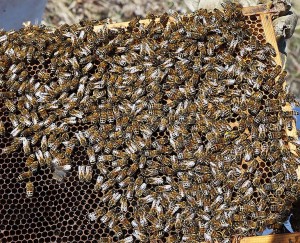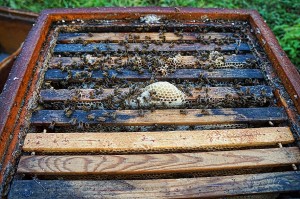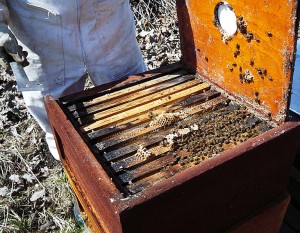In 2007 Karin worked on becoming a commercial beekeeper. She wintered 30 bee colonies. She invested in honey extracting facilities. In spring 2008 she had 2 colonies left. In the county where she lived Varroa had just arrived and the same winter many died in the county due to the mite. Life was full of duties and she forgot about the bees and the two surviving colonies was forgotten. They were the only bee colonies in the neighborhood now. Corn has been farmed in big areas, starting about the same time as the bees began to die. But where Karin has her survivor there are a lot of white clover as well blooming at the same time, much more visited by the bees.
Sven got some swarms a couple of years later coming from the direction from where Karin lived some 3 km from where she had the survivors.
October 2012
Last year it was one colony left and I said to Sven we had better visit Karin and make sure the colony survived another winter so we could breed from it. It might have some valuable survivor traits. Sven talked to Karin late in autumn, an unusually warm one. A week later we arrived to find the colony. Karin had put on a bucket of sugar solution which was empty after just a week then, inspired by her conversation with Sven. She added another one which they also took. Actually earlier last summer in 2005 Karin had harvested 2 frames of honey, which was the first time since autumn in 2007 she had opened the hive.
The colony seemed to be healthy in October 2005. It was not super strong, but a cluster big enough to be able to survive in the well insulated plastic hive.
April 2013
Today April 27 it was a sunny day. Willow was giving nectar and pollen. I went to visit Karin to find out if she was a beekeeper. So I asked her. Yes, she said. They are flying. Ok, let’s go and look. So we opened the hive.
Somewhat weaker colony than in October. It looked healthy with no signs of spring problems, no spots on the frames. And capped brood. 
This is the last comb with bees with some brood. As far as I could see the bees were not on small cell size, but the two honey frames taken last summer in 2005 had been replaced with 4.9 mm cell size foundation. The bees had not succeded in drawing it well. It was not too badly drawn, but many cells were bigger.
Now we saw another surprising thing. At on lower front corner the bees were entering. Below was a lot of pollen. The bees were squeezing themselves into the hive above the wooden list of a queen excluder on the bottom board! How in the world… could they have swarmed and get themselves a new mated queen – or had they lived small all the time due to small incoming amounts of pollen due to the excluder on the bottom and the queen were still the same old one?
In June Karin plans to split the colony and start expanding her beekeeping again. Will her bees endure the changes in the management now taking place and still survive?

